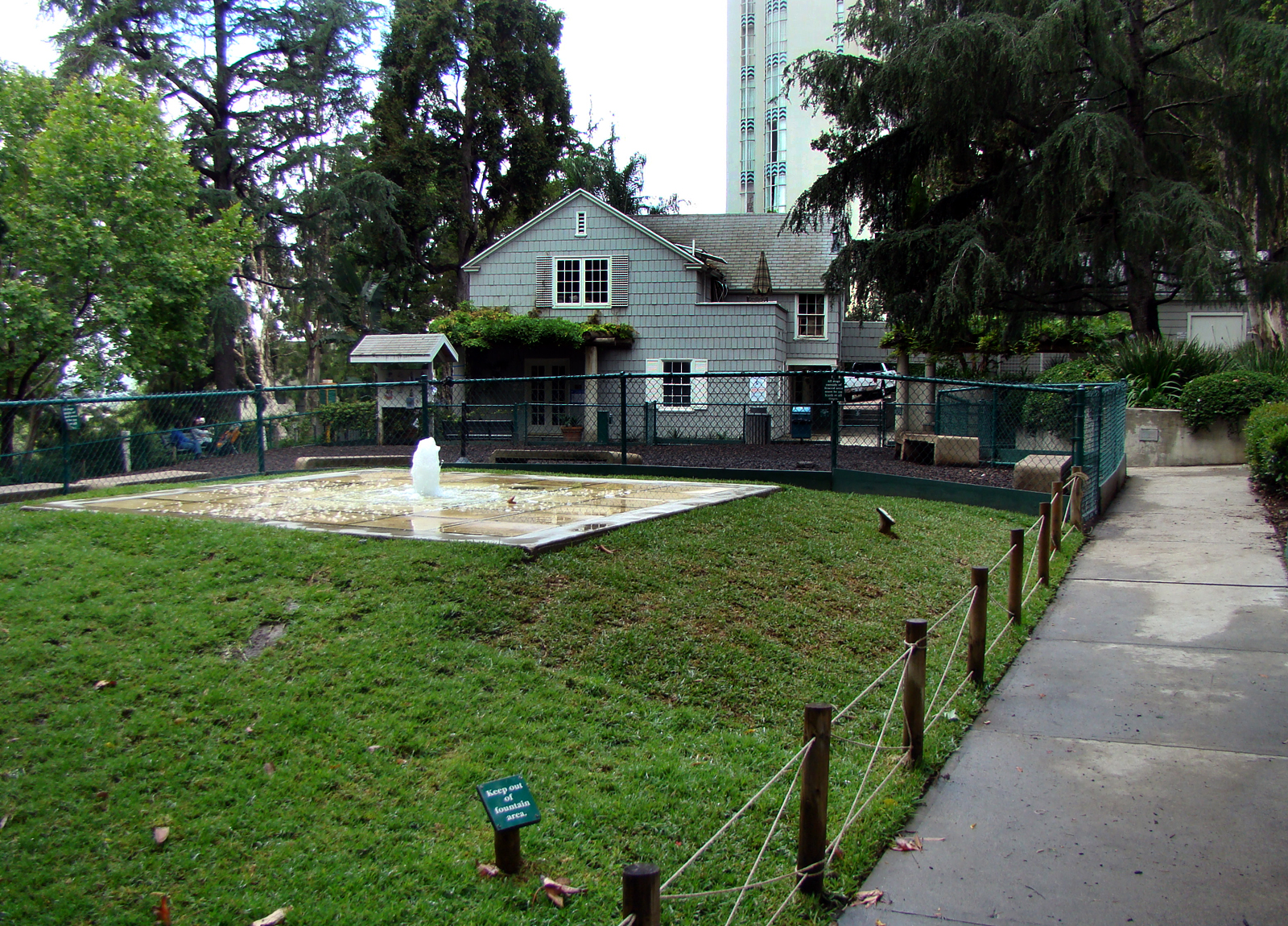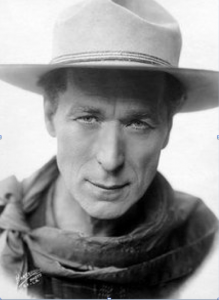
Dog parks usually don’t come with a long-running family mystery and a healthy dollop of Hollywood intrigue, but then again, nearly everything about how West Hollywood came to operate – but not own – William S. Hart Park is out of the ordinary.
The one-acre dog park at 8341 De Longpre Ave. is named after silent film’s original cowboy, who was among the biggest box office stars of the 1920s. Hart owned the estate and lived in its two-story ranch house from 1919 to 1927.
Hart was humbly grateful to his many fans, always true to the spirit of his on-screen persona of being honest and forthright. “While I was making pictures, the people gave me their nickels, dimes and quarters. When I am gone, I want them to have my home,” he once told friends and family.
Two years before he died in 1946, Hart made the city of Los Angeles an offer it couldn’t refuse. He would give Los Angeles his hillside estate that fronted De Longpre Avenue but backed up to Sunset Boulevard and $50,000 in exchange for a promise to erect a fountain there and preserve the estate as a park in his honor.
It was an unusual proposition from the outset. Hart’s son, Willian S. Hart Jr., and others believed the larger than life cowboy actor originally intended to give the estate at the foot of the Sunset Strip to Los Angeles County – as he later did with his 260-acre ranch near Saugus – and may have contacted the city by mistake, since the nine-room house wasn’t in Los Angeles. City officials accepted the actor’s generous offer nonetheless, and Hart made the gift official with a formal announcement in December 1944.
“I would like to say in all the sincerity of which I am capable that donating this beautiful spot … my former home, I am only trying to do an act of justice,” the 72-year-old actor told a gathering of A-list celebrities and politicians on the front lawn of his De Longpre Avenue estate. “I am only trying to give back to the American public some part of what the American public has already given to me.”
Work on Hart Park was supposed to have begun shortly following his death in 1946. The Los Angeles Parks Department, though, found the prospect of developing a park outside its boundaries to be troublesome. Nothing was done to give Hart the park he wanted until more than 43 years later when the city of West Hollywood took over the park’s operations in 1989.
Los Angeles Forgets About Hart Park Promise
If Hart made a mistake, it might well have been placing his trust in the Los Angeles Parks Department to share many of the same values as the characters he portrayed in more than 50 films during his career.

Few could have predicted how quickly Los Angeles would forget all about developing Hart Park as it had promised. Parks Department officials probably made their boldest move in 1951, a full 17 years after the property came under their management. They asked the city attorney for a legal opinion on whether Los Angeles was contractually required to develop the park.
Showing a firm grasp of the obvious, the city attorney determined that Hart’s will indeed obligated Los Angeles to develop the park. But the legal opinion found further that the city did not have to honor Hart’s request for a fountain. The exercise was all for naught because nothing was done, as usual, and vandals took their toll inside the stately home.
Los Angeles occasionally leased the house to various tenants until 1968 when the West Coast branch of the Actors Studio moved in. The Actors Studio refurbished the four-bedroom, two-bathroom house, turning it into a rehearsal space, office and caretaker quarters. The group also converted the garage into an 84-seat theatre workshop.
West Hollywood Paws After Park
The unimproved parcel on Hart’s estate where he wanted a park built became something of a well-kept secret, according to the Los Angeles Times. A 1988 article notes, “The park was so obscure that West Hollywood city officials didn’t even know it existed until they were tipped by a developer eight months after the city’s incorporation in 1984.”
The estate was the focus of controversy in 1985 after owners of the exclusive St. James’s Club next door (now the Sunset Tower Hotel) tried to persuade the city of Los Angeles to allow them to dispose of the house and build a multistory parking garage on the site, topped by a rooftop park at the level of the boulevard.
A coalition of neighborhood groups, the Sierra Club and Hart Jr. opposed the developer’s proposal. The battle took four more long years to play out, but ultimately, the plan for a parking garage was denied by respective planning and review authorities in both cities.
The two struck a deal in December 1989 that neither wanted to refuse. Los Angeles agreed to turn over Hart Park to West Hollywood under a 30-year lease agreement along with the trust fund that had grown to $284,000. The pact paved the way for a long-awaited renovation of the park costing $750,000.
West Hollywood had two other parks at the time and was eager to have the estate as another one. It leased the property month-to-month for several years from Los Angeles, and stepped up negotiations in 1986 for a long-term lease after the proposed parking garage was turned back.
Both cities considered the agreement to be ideal for each. Densely populated West Hollywood got a choice acre of sorely needed park space, while L.A. was relieved of a long-standing commitment it never wanted.
“It’s really a fluke that the park’s development took this long,” said Robert Vulcan, a longtime resident who headed the West Hollywood Historical Society at the time. “L.A. didn’t care about it. The county wasn’t interested. And the immediate neighbors for the most part favored the status quo. More than anything else, it was a case of nobody pushing and nothing getting done.”
West Hollywood officials called the park “a tribute to Hart’s attention and care for animals.” Hart Park is home to an AIDS memorial in the form of a small grove of liquidambar trees surrounding a compact amphitheater.
West Hollywood used trust funds to develop the park and dedicated it in Hart’s honor on his birthday (Dec. 6), 1991.

Hart House Is Oldest Structure on Sunset Strip
Hart’s residence was built in 1919, according to Los Angeles County Tax Assessor records, making it the oldest building along the Sunset Strip through West Hollywood. The always reliable website, “Playground of the Stars,” reports that the second oldest is the commercial building where the Viper Room is located today. It was built in 1921.
The De Longpre estate also was the cowboy actor’s first California home and where he wed actress Winifred Westover in 1921. In a classically awful Hollywood marriage, they had met a few months earlier on the set of the silent cowboy picture “John Petticoats.” He was 58 at the time and his wife was a young starlet of 21 years. They separated five months later when she was pregnant with Hart Jr. and formally divorced in 1927.
The house represents a special point in motion picture history, the Los Angeles Times observed. Along with Charlie Chaplin, Mary Pickford and Douglas Fairbanks, Hart was among the biggest box office stars of his time.
“Hart moved into the house on De Longpre in 1919 at a time when some of the most important names in show business were acquiring expensive properties as part of the first onslaught of Hollywood’s wealth. He lived there until 1927 when work was completed on the Saugus ranch 40 miles north of Los Angeles,” the newspaper said.
Did Los Angeles Mismanage Hart’s Trust Fund Too?
The 30-year lease agreement between Los Angeles and West Hollywood was approved over claims by Hart’s son that Los Angeles had mismanaged the trust fund. Hart Jr. supported the $750,000 renovation but asked that a long-term lease be delayed until L.A. conducted “an immediate accounting” of the fund. The 67-year-old real estate appraiser estimated that the fund should have been worth more than $800,000 based on interest rates since 1944 when his late father donated $50,000 for the park.
“I would just like to see justice done and my father get something that he paid for,” he told city representatives.
The general manager of Los Angeles’ Parks Department in 1989, James D. Hadaway, contended that a three-page report prepared by the city in 1987 of the trust fund was an “adequate accounting.” He noted that the full $50,000 wasn’t invested over the years “because of current and anticipated expenditures.”
Hadaway acknowledged that the fund could have been invested differently but maintained the Parks Department chose investments that “provided a greater degree of liquidity and security.”
Since the city wasn’t developing Hart Park, Hadaway’s explanation raised questions about which expenditures had been paid for by the trust fund, Hart Jr. said. “I’m beginning to suspect that they spent the money,” the actor’s son said. “I believe it was just thrown into the general fund and that it was forgotten about.” He added, “But it is as though (Los Angeles officials) just don’t give a damn.” Los Angeles never provided the detailed accounting that Hart Jr. sought before he passed away in 2004.
‘Giving Back’ Omitted Son from Will
The son spent a great deal of his time in courtrooms arguing over his father’s estate. First, as the elder Hart’s health deteriorated in 1946, friends went to court seeking guardianship of his person and his estate.
Hart Jr., then in his mid-20s, sued for the job himself and won a partial victory. A judge ultimately named the son co-guardian of the father’s person and Hart Sr.’s tax consultant was named sole guardian of the estate. Second, the elder Hart’s spirit of giving back only went so far as he gave nothing to Hart Jr. in his will, denying his only child a part of either estate. Hart Jr. fought unsuccessfully during the 1950s and 60s to overturn his father’s will.
After years of lengthy litigation, the son was unable to convince a jury or appellate court that his father had been unduly influenced by others to exclude him from the will. The actor, who had established a $100,000 trust fund for the boy before he was born, clearly stated in his will, “I have made no provision in this will for my son for the reason that I have amply provided for him during my lifetime.”

Effective immediately, June 2, 2016. Hart Park has an opening for one community member to apply for the Hart Park sub-committee, this is a great opportunity to get involved making Hart Park the best off leash dog park in West Hollywood. If interested in this opportunity, please acquire an application for West Hollywood’s City Clerk’s office. This is an awesome opportunity to become involved in Public Facilities and West Hollywood government. We meet at Hart House/dog Park on a quarterly basis on the fourth Wednesday of that month at 6-8pm. Hope to hear and see you soon. Become active in… Read more »
This is a beautiful story and offers a facility rich with history, culture and fully functional off-leash dog park. The City and Public Facilities has a sub-committee with open public committee member seats available. This offers those with an interest to join this committee and have a voice, vote on all aspects of update to the dog park design, configuration and improvements to the off-leash and park area that is currently on-going. Anchored by the beautiful Hart House please considered, on a quarterly basis, meeting with our sub committee to make Hart Park off-leash dog park the best it can… Read more »